Grazing cattle on a diverse forage crop could benefit soil health, biodiversity, and your purse
17th January 2023
The results of an ongoing Innovative Farmers field lab indicate that diverse winter grazing crops offer major benefits to soil health and biodiversity, as well as the potential to cut input costs while farming in harmony with nature.
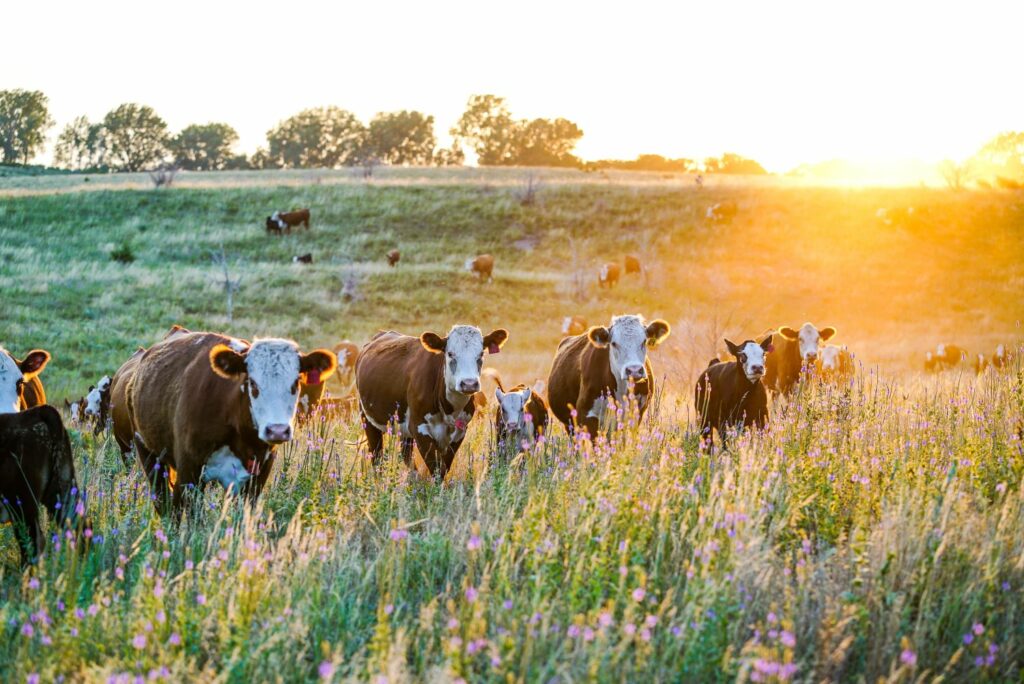
Stock photo for illustration purposes only.
The trial involves farmers comparing their usual winter forage of a brassica mono-culture with a diverse, 16-species fodder crop mix – including clovers, hairy vetch, ryegrass, spring oats, kale and linseed.
The aim is to investigate whether the multi-species mix can reduce soil erosion and increase biodiversity by creating habitats for wildlife, while also providing a nutritional crop that maintains animal health and performance.
The results so far are really encouraging, according to project coordinator Sarah Whaley from the Farming Wildlife Advisory Group (FWAG).
The concept behind the trial
It is common practice among beef farmers to graze their cattle on a single brassica forage crop over the winter, such as kale or fodder beet, in order to reduce feed costs and indoor time for the herd.
However, many farmers are dissatisfied with the current system of monoculture winter brassicas as it damages soil health, increases surface runoff and causes issues in the wider environment despite providing low-cost and reliable forage. In addition, mono-crops are more susceptible to pests and diseases, requiring higher chemical and fertiliser inputs.
However, high nitrogen content and low fibre availability mean the rumination and general contentment of the animals can be compromised if left to graze on the fields alone. Therefore, farmers must provide supplementary hay to maintain growth rates, which adds to the workload and can create considerable destruction on fields.
Inspired by the success of a similar practice in New Zealand, the field lab set out to test whether the higher biomass of a diverse crop can boost farm resilience by protecting the soil structure. Amongst others, farmers were hoping to see reduced erosion and runoff, and higher worm counts, infiltration rates, and water holding capacity.
Ran in partnership with FWAG in the South West, research elements and overall project management have been carried out by ecologists and soil researchers, who also provided farmers with a wealth of knowledge on the importance of farming on healthy soils.
Elaborating on the concept behind the trial, Sarah Whaley from FWAG said: “Plants work better in a community, and diversity supports the beneficial symbiotic relationships both above and below ground.
“While conventional farming practices have relied on mono-cropping as a rule, there is much research around improved responses in soil health, animal performance and wider environmental benefits from bringing in diversity.
“Whilst winter brassicas are valuable to farmers, this field lab aims to investigate if there is an alternative way that offers a multitude of benefits over forage value alone.”
She added that the crop mix developed for the trial is not a “one-size-fits-all solution” and its success will vary depending on the soil type and climate of farms amongst other factors.
If successful, establishing diverse seed mixes could be rewarded in the government’s Environmental Land Management schemes (ELMs) which currently require farmers to have “no more than 5% bare ground over winter.” Moreover, by reducing fertiliser inputs, diverse forage crops could also contribute to meeting the industry’s Carbon Net Zero targets.
Trial design and early establishment
The field lab was set up in May 2022 on four beef cattle farms in Devon and Somerset, of which two are organic and two conventional. Each farmer was required to establish a 4 ha plot of forage brassica or fodder beet as per their “normal” system and an equal-sized plot of the diverse forage crop.
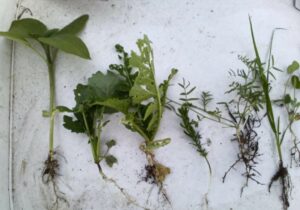
A display of some of the species included in the diverse mix.
Drilling of the two crops was either carried out on the same field or adjacent fields to match soil type and growing conditions. Prior to crop establishment, soil sampling was carried out to determine nutrient availability.
The 16-species mix was selected by farmers for soil health, ecological benefits, birdseed, winter hardiness and fodder potential. The components of the mix, of which 27.275 kg was sown per ha, can be viewed on the Innovative Farmers website.
For the following 12 months, the trial set out to monitor and measure the potential of the diverse mix to:
- maintain animal health, welfare and performance
- extend winter grazing and produce a ‘second bite’ of grazing in early spring, depending on regrowth
- improve soil quality for the following cropping season
- boost biodiversity by creating a habitat for multiple species like pollinators and invertebrates, including insects and seed that are a food source for bats and birds
- reduce soil erosion, compaction and run-off of sediment and nutrients into waterways
- decrease pest and disease pressure requiring fewer inputs
- reduce indoor housed winter feed, incurred costs, and use of fossil fuels.
Cattle was weighed and body condition scored prior to the trial and have been closely monitored on both trial and control fields. Moreover, visual evaluation of soil structure (VESS) scoring, earthworm counts, and rhizosheath monitoring were also carried out throughout the field lab as part of the holistic soil management system implemented on trial fields.
The farmers participating in the trial have reportedly been very enthusiastic and cooperative, eager to discover the benefits diverse forage has to offer. Some have already experimented with grazing cover crops of four to seven species including grasses and annual clovers with good results.
Triallist George Greed, who farms 280 cows on his organic farm in Devon, said:
“I passionately believe I have a responsibility, as a farmer and custodian of this land, to do what I can to support biodiversity. From providing shelter and food for wildlife and pollen for bees to providing a more diverse source of winter bird food, I am interested to find out what benefits diverse fodder can provide.”
His opinion is echoed by other participants, including Chris Berry, who farms a 180ha conventional farm supporting 900 breeding ewes and lambs alongside 65 head of beef cattle near Exeter.
He said: “There is quite a bit of unknown within this trial, but I think we all agree there is massive potential. As a curious farmer who out-winters most of our livestock, I am always looking to improve or seek out better alternatives to achieve the best all-round sustainable outcome for the soil and livestock health.”
Animal health and welfare has been a top priority throughout the trial, and farmers had complete autonomy over management decisions to suit their livestock. For example, it was up to the farmers to decide when to start feeding hay or how often to move cattle within their strip or cell grazing systems.
Speaking to Farmers Guide, Sarah Whaley said the establishment of the trial mix has varied between farms depending on the timing of drilling and available moisture, but has overall been satisfactory. Some species, such as the tillage radish and vetch, were more dominant and spread quickly, while a small number of species failed to germinate entirely.
Results so far show potential for the future
According to Ms Whaley, the beneficial effects provided by the diverse mix were evident from very early on following establishment. When compared with adjacent mono-crop fields, there was significantly greater pollinator presence on the trial side, owing to the greater amount of forage available for these species.
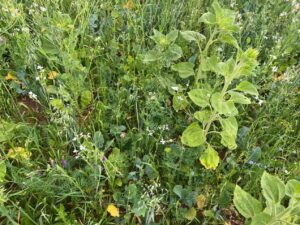
A closer look at the 16-species mix on a trial field.
Invertebrates in general were also far more abundant in numbers and diversity on trial fields, which had a knock-on effect on bird numbers, Ms Whaley said. Meanwhile, the kale crop on the control fields attracted a large number of cabbage white butterflies, but was lacking in most of the diversity and ecosystem services benefitting the trial fields.
In terms of soil health, the complex and dense root structure of the multispecies crop produced very stark results when compared to the simple rooting system of the kale crop. To illustrate the magnitude of the effect, Ms Whaley shared observations from a farm where a single 8 ha field was divided between the 16-species mix and the kale crop.
Despite the two plots having had the same tillage and soil structure, sampling revealed vast differences in the soil structure on either side. Ms Whaley described the trial side having the “ideal chocolate cake texture” with the soil being friable and crumbly, while the soil on the kale side was noticeably more compact with obvious layering.
“There seems to be less compaction [on the trial side], much greater organic matter, deeper rooting and greater root biomass which helps the soil structure with the roots exudates feeding soil microbial activity,” Ms Whaley explained in an interview with Farmers Guide.
Moreover, the diverse mix had considerably less disease and pest pressure, likely due to the diversity of species counteracting the overabundance of a single population of pests, Ms Whaley said. While there were instances of aphids or dock persisting on mono-crop fields, the multispecies mix remained largely unaffected.
“The diverse mix probably reduces the risk of a single species being attacked by a single pest and farmers losing a whole crop as there are other species that are more resilient,” Ms Whaley added.
Presenting at the Oxford Real Farming Conference on the 6th of January, Ms Whaley provided some more recent updates on the trial, which was 6 months in progress at the time.
Cattle have been grazing on the fields since November and have been content on both sides. However, due to all farms moving through their mixed species plots at a high rate and the kale crop not providing enough fibre, supplementary feeding of hay was necessary on both sides.
At the same time, while the diverse mix has evidently lost a lot biomass, that material has gone back into the soil to benefit the underground ecosystem, unlike the kale stalks, Ms Whaley pointed out. She added that soil health appears to be a lot better on the mixed species plots, with the animals being held out of the mud and working less hard.
There have also been signs of regrowth on the mixed fields, and it will be interesting to see whether the animals will get a second bite in the spring which they certainly won’t get from the kale crop, Ms Whaley said.
A strong advocate of regenerative agriculture and agroecology, Ms Whaley emphasized that managing a living system is never linear and farmers have to be flexible to adapt to the needs of their soil and livestock.
Considering the multitude of benefits diverse seed mixes can provide, she encourages farmers to experiment with multiple species and monitor what works best on their farm. After all, seed cost is negligible compared to the costs associated with soil destruction caused by the current system of monoculture winter brassicas, she added.
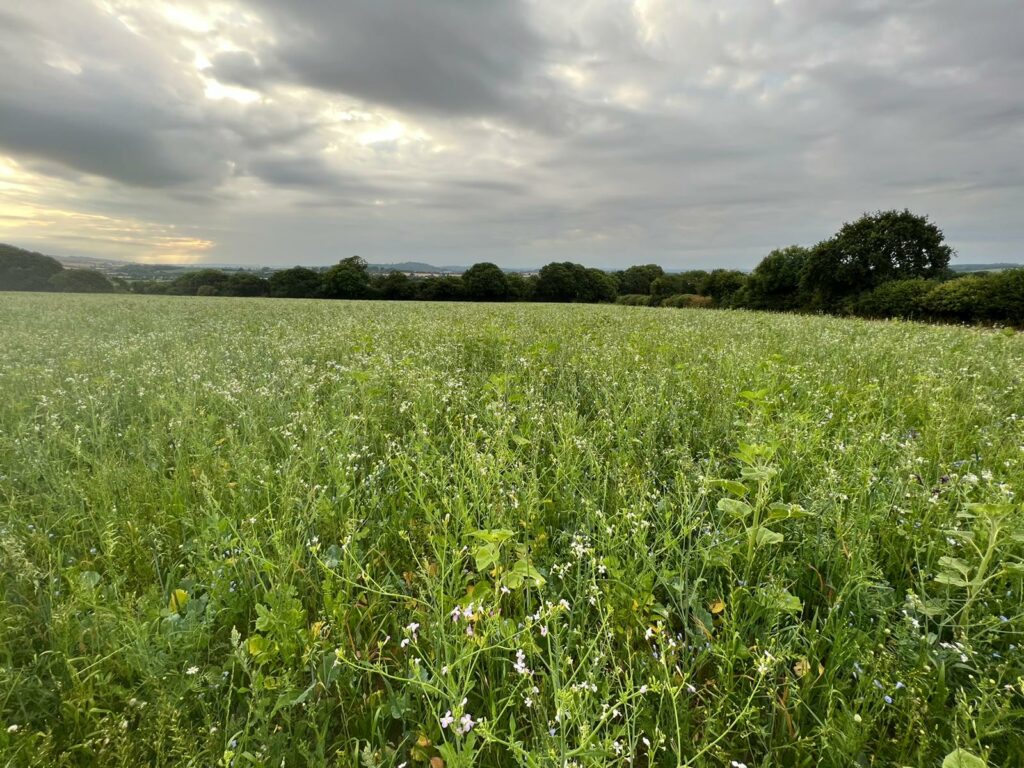
Trial field showcasing the diverse crop mix.
Regarding the potential impact diverse fodder crops could have on farm resilience and the wider environment across the UK, Rebecca Swinn, Innovative Farmers manager said:
“Success could help farmers increase biodiversity, capture carbon, and protect their most valuable resource – soil. Field labs mean that the results can be put directly to use so practices can change in real time. Giving farmers the confidence to test these ideas is what Innovative Farmers is all about.”
“If you look after nature, it will look after you”: A triallist’s view
Richard Stanbury, one of the participants of the trial, farms about 450 head of beef cattle and lambs around 900 ewes on his farm in Devon. In an interview with Farmers Guide, Mr Stanbury related his experiences with the trial so far and shared his views on farming in harmony with nature.
With his beef operation, he has been aiming to finish as many followers as possible on a grass-based diet and to ultimately outwinter the entire herd. In recent years, the farm gradually transitioned away from the single monoculture system to drilling plant mixes of two to three species including brassica, oats and ryegrass.
Mr Stanbury’s initial aim with the trial mix was to give the animals the crop in the field rather than having to supplementary feed. “This way, they would graze quite naturally outdoors, get what they need and be happy, and also wouldn’t be stood around one spot eating the round bale and destructing the soil,” he remarked.
Like other participants, Mr Stanbury was also surprised at the striking difference the 16-species mix made to the soil and the welfare of his animals. He recalled the day his farm received four inches of rain during the first week of winter grazing and said it was rewarding to see how well the mix coped.
While there was a lot more poaching and standing water on the kale side following the downpour, the trial plot had shown hardly any signs of heavy rain, with the soil being a lot more free-draining due to the root structure.
Worm counts have also been higher on the trial side with significantly more biodiversity observed above ground. Mr Stanbury said the cows also lied down more frequently on the trial side due to the ground being much less compacted, which positively affects their welfare.
“It gives you happiness that you are doing your bit for the environment, a bit of pride,” he told Farmers Guide. “The public will also be on your side if they see farmers giving back to the environment.”
When asked about the challenges encountered during the trial, Mr Stanbury said the main struggle with the mix was determining the size of land to seed on. As some species like the radish or sunflower provide no nutritional value to cattle, the mix offers less dry matter overall and requires a larger area to satisfy the needs of livestock.
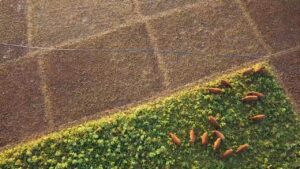
Even though the multispecies mix has mostly been grazed down on Richard Stanbury’s farm, the first signs of regrowth are already evident.
At the end of the day, even if there is a need for supplementary hay and growth rates are the same on both sides, Mr Stanbury said the seed mix offers massive benefits with reduced soil impact and poaching and a potential re-graze in the spring.
He recommends farmers give the seed mix a try and see how it works on their farm, starting with three or six varieties and gradually building it up based on the needs of the soil and livestock.
“By doing it this way, we’re farming with nature, wildlife, and still farming productively. Those two things work hand in hand,” he said.
In his final remarks, Mr Stanbury reminded farmers of the importance of keeping an open mind and trying new things, especially in the face of challenging times that lie ahead.
To keep up to date with the progress of the trial and to learn more about farmer-led research, visit: www.innovativefarmers.org
